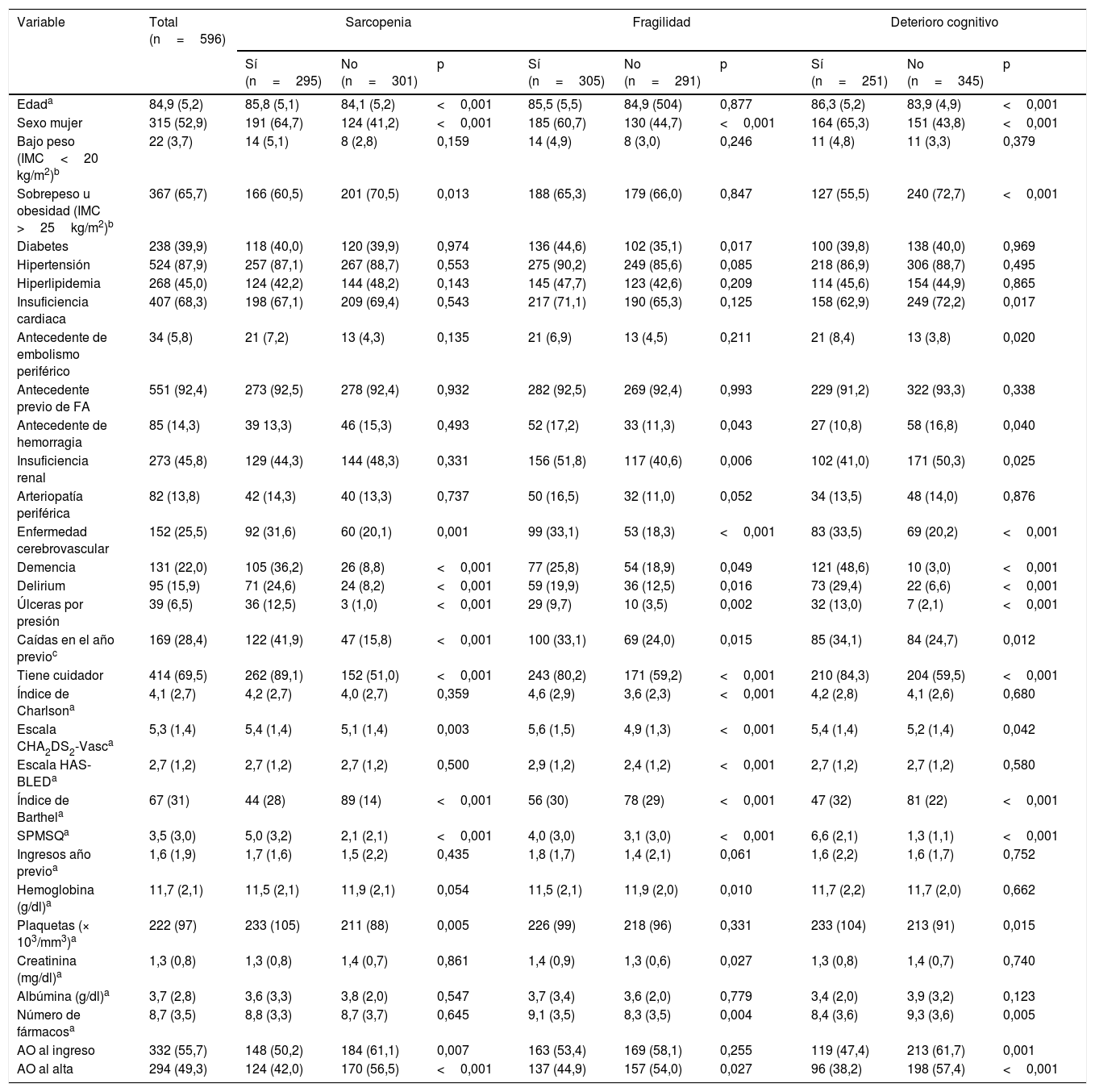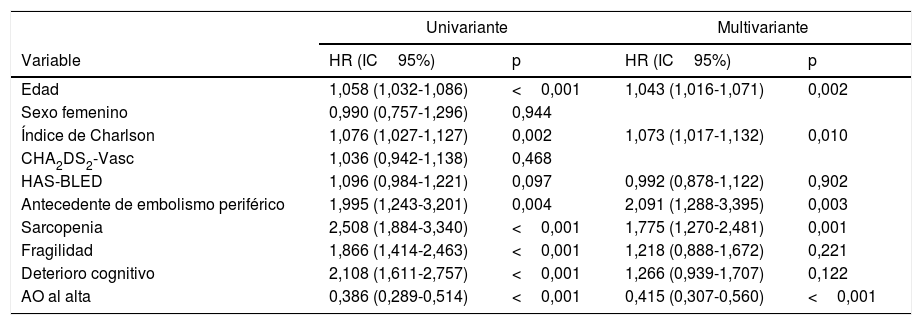Determinar la prevalencia de la sarcopenia, la fragilidad y el deterioro cognitivo en pacientes ancianos con fibrilación auricular no valvular (FANV) y su influencia en la supervivencia.
MétodosEstudio de cohortes, prospectivo y multicéntrico realizado con pacientes >75años con FANV hospitalizados en servicios de Medicina Interna en España. Para cada paciente se recogieron los niveles de creatinina, hemoglobina y plaquetas, así como las escalas CHA2DS2-Vasc, HAS-BLED, el índice de Charlson y el uso de anticoagulantes orales. Se midió la sarcopenia con escala SARC-F, la fragilidad con la escala FRAIL y el deterioro cognitivo con el Short Portable Mental State Questionnaire. Se realizó seguimiento durante un año.
ResultadosSe incluyeron 596 pacientes con FANV, con edad media de 84,9 (DE: 5,2) años. De ellos, 295 (49,5%) presentaban sarcopenia, 305 (51,2%) fragilidad y 251 (42,1%) deterioro cognitivo. Al cabo de un año fallecieron 226 (37,9%) pacientes. La mortalidad fue superior en los pacientes con sarcopenia, fragilidad y deterioro cognitivo. En el análisis multivariante la sarcopenia (HR: 1,775; IC95%: 1,270-2,481), la edad, la comorbilidad y el antecedente de embolismo periférico se asociaron con mayor mortalidad, y el uso de anticoagulantes orales al alta (HR: 0,415; IC95%: 0,307-0,560), con menor mortalidad.
ConclusionesEn los pacientes ancianos con FANV la sarcopenia, la fragilidad y el deterioro cognitivo son muy prevalentes y se asocian con frecuencia. La sarcopenia se asocia a mayor mortalidad.
To determine the prevalence of sarcopenia, frailty and cognitive impairment in elderly patients with nonvalvular atrial fibrillation (NVAF) and the factors’ influence on survival.
MethodsProspective, multicentre cohort study of patients older than 75 years with NVAF hospitalised in internal medicine departments in Spain. For each patient, we recorded the creatinine, haemoglobin and platelet levels, the scores on the CHA2DS2-VASc and HAS-BLED scales and Charlson index, as well as the use of oral anticoagulants. We measured sarcopenia with the SARC-F scale, frailty with the FRAIL scale and cognitive impairment with the Short Portable Mental State Questionnaire. We also conducted a 1-year follow-up.
ResultsThe study included 596 patients with NVAF, with a mean age of 84.9 (SD: 5.2) years. Of these, 295 (49.5%) presented sarcopenia, 305 (51.2%) presented frailty, and 251 (42.1%) presented cognitive impairment. At the end of 1year, 226 (37.9%) patients had died. Mortality was greater for the patients with sarcopenia, frailty and cognitive impairment. In the multivariate analysis, sarcopenia (HR: 1.775; 95%CI: 1.270-2.481), age, comorbidity and a history of peripheral embolism were associated with increased mortality, and the use of oral anticoagulants at discharge (HR: 0.415; 95%CI: 0.307-0.560) was associated with lower mortality.
ConclusionsSarcopenia, frailty and cognitive impairment are very common in elderly patients with NVAF and are frequently associated. Sarcopenia was associated with increased mortality.
Article
Diríjase desde aquí a la web de la >>>FESEMI<<< e inicie sesión mediante el formulario que se encuentra en la barra superior, pulsando sobre el candado.

Una vez autentificado, en la misma web de FESEMI, en el menú superior, elija la opción deseada.

>>>FESEMI<<<










